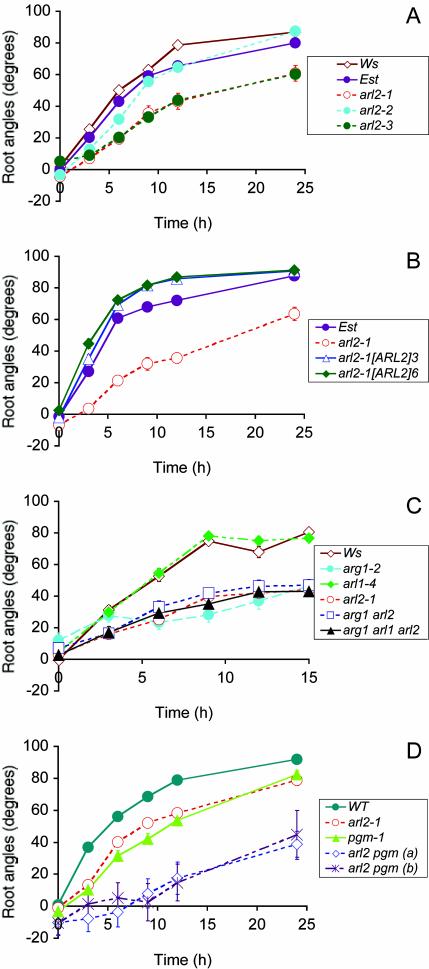Figure 1.
Gravitropic phenotype of wild-type, arl2, and arl1 mutant seedlings in darkness (A and C) or in light (B and D). Average root tip angles from the horizontal are shown at each time point. In A to D, genotypes of tested seedlings are indicated in a legend box. A, Root gravitropism of wild-type Est, Wassilewskija (Ws), and arl2-1, arl2-2, and arl2-3 mutant seedlings. This graph shows the results of two independent experiments, one involving Est and arl2-1, the other one involving Ws, arl2-2, and arl2-3. Wild-type Ws seedlings were included in both experiments, where they showed almost identical kinetics of root gravitropism (data not shown). Hence, we show only the Ws response for the second experiment. n = 33 to 84 for the first experiment and 38 to 120 for the second experiment. B, Root gravitropism of wild-type Est, untransformed arl2-1 mutant seedlings, and progeny of two independent arl2-1 transformants carrying the p35S-His6::ARL2 construct (arl2-1[ARL2]3 and arl2-1[ARL2]6, respectively; n = 41-53). C, Root gravitropism of wild-type Ws, single mutants arl1-4, arg1-2, and arl2-1, double mutant arg1-2 arl2-1, and triple mutant arg1-2 arl2-1 arl1-4 (n = 28-61). D, Root gravitropism of wild type (WT), single mutants arl2-1 and pgm-1, and double mutant arl2-1 pgm-1 seedlings. All wild-type and mutant lines tested in this experiment were derived from individual segregating F2 progeny from a cross between arl2-1 and pgm-1. Two independent arl2-1 pgm-1 double-mutant lines (a and b) were analyzed (n = 14-40). In A to D, vertical bars representing ses are shown at each time point. However, they are often masked by the curve symbols.

